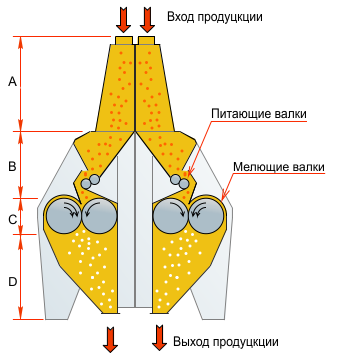Pneumatic Grinding Mill (working Principle)
The pneumatic roller mill is one of the most important units in the mill. The pneumatic roller mill is the first line of flour milling equipment. The choice of a pneumatic roller mill is determined by the required quality and quantity of flour.
In the grinding system, the pneumatic roller mill simultaneously performs the functions of crushing, cutting and pressing the grain. As part of the mill complex, the pneumatic roller mill is located in the grinding department and mainly on the ground floor.
Therefore, this unit is indispensable for obtaining products with desired properties after grinding cereals or grains of similar hardness.

Principle of Operation
01. Introduction section > 02. Feeding section > 03. Grinding section > 04. Product output
The product enters the pneumatic roller mill through the upper suction tube and is distributed evenly over the entire length of the grinding rollers thanks to the feed rollers. Milling rollers (grooved or smooth) turn towards each other, grind the incoming product. The milled product enters the receiving chamber of the machine, then into the pneumatic receiver, where it is transported to square sieves. In addition, the quality and efficiency of the roller mill is affected by the gap size and the stability of its size along the entire length of the rollers.
The main indicators of the efficiency of roller mill are affected by the ratio (differential) of the circumferential speeds of the rollers, the surface condition and the accuracy of the gap along the length of the rollers. Increasing the circumferential speeds of rollers with a fixed differential significantly increases efficiency, but slightly increases energy consumption and does not affect the granulometric composition of the crushed product.
You can see the full list of roller machines sold by Molinus in the catalog.